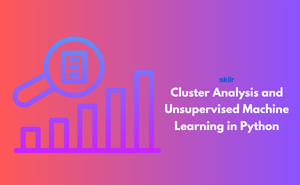👇 CELEBRATE CLOUD SECURITY DAY 👇
00
HOURS
00
MINUTES
00
SECONDS

Unsupervised Machine Learning and Cluster Analysis using Python focuses on exploring data to find hidden patterns without prior labeling. Instead of predicting outcomes, the model organizes data points into meaningful groups or clusters, revealing relationships and similarities that might not be obvious at first glance.
By mastering this skill, learners can use Python tools to segment data, spot outliers, and extract actionable insights. This certification provides hands-on experience with algorithms and visualization techniques that help analyze large datasets, making it easier to understand and interpret complex information without relying on pre-labeled data.
This exam is ideal for:
Industry-endorsed certificates to strengthen your career profile.
Start learning immediately with digital materials, no delays.
Practice until you’re fully confident, at no additional charge.
Study anytime, anywhere, on laptop, tablet, or smartphone.
Courses and practice exams developed by qualified professionals.
Support available round the clock whenever you need help.
Easy-to-follow content with practice exams and assessments.
Join a global community of professionals advancing their skills.
A technique to group similar data points into clusters without predefined labels.
ML that identifies patterns in data without labeled outputs.
Yes, basic Python programming and Knowledge of libraries like pandas and scikit-learn.
Data analysts, data scientists, business analysts, researchers, and ML enthusiasts.
Yes, clustering helps identify distinct customer groups for targeted strategies.
K-Means, Hierarchical, and DBSCAN clustering algorithms.
Yes, for interpreting and presenting clusters using Python libraries.
Yes, outliers can be identified as points not belonging to any cluster.
Basic understanding is sufficient; deeper statistical knowledge is optional.
Absolutely, it’s useful for analyzing unlabeled datasets and discovering patterns.